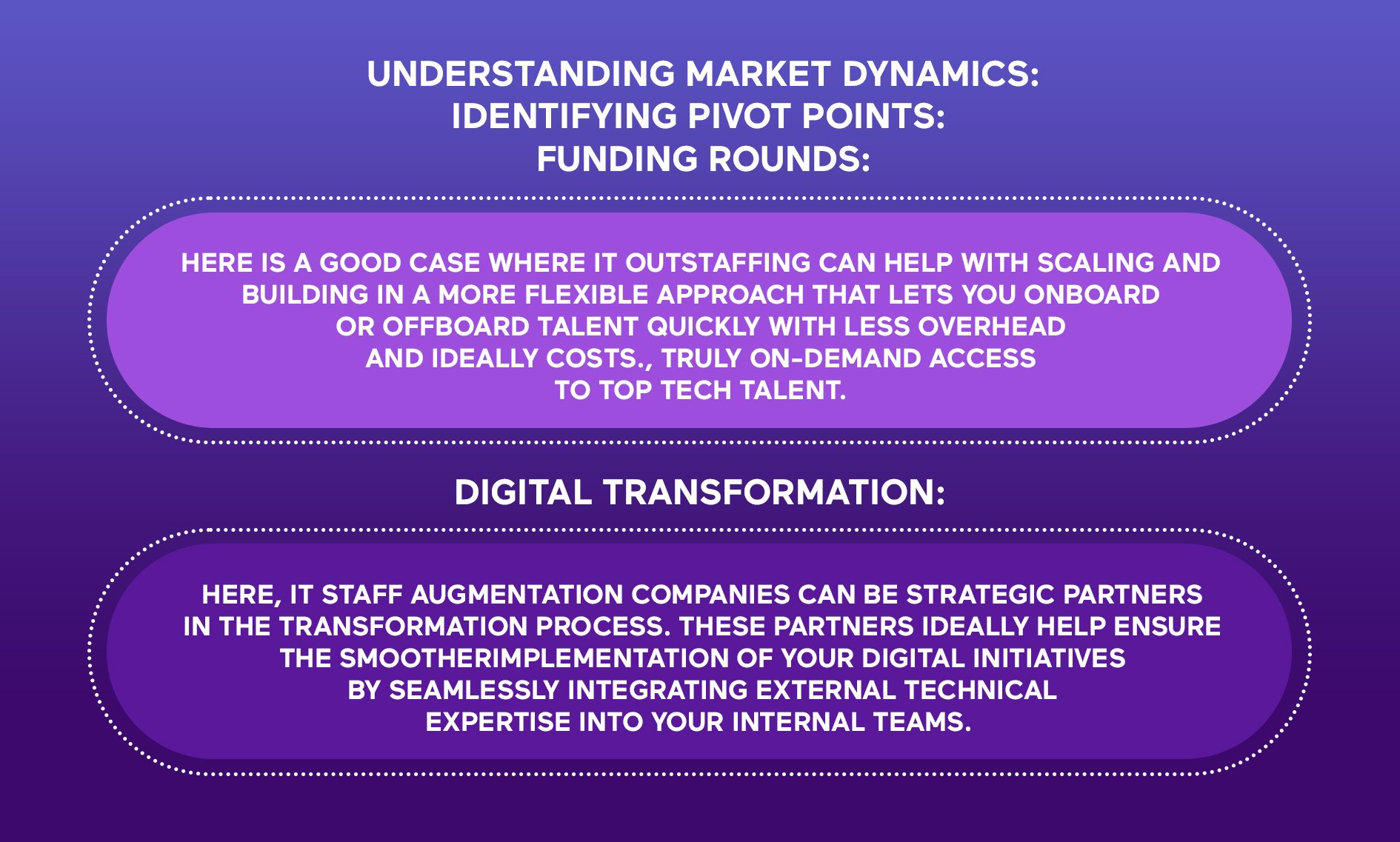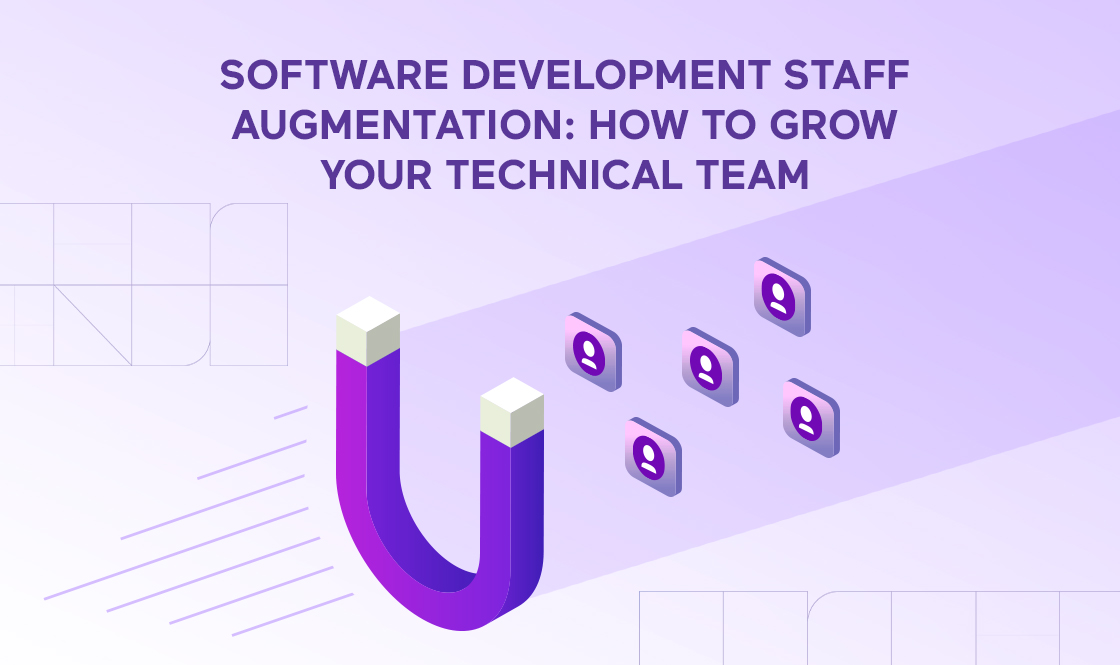I have seen firsthand how our business and the businesses we work with have used staff augmentation solutions to not only weather the turbulent labor market dynamics but to emerge with scalable and flexible options for growth and profit.
Understanding Market Dynamics: Identifying Pivot Points

Moments of pivotal, transformational change within a company are scary but open up opportunities. Raising an investment round or moving a large part of an offline business to online, in particular, stands out as critical pivot points where the path of a company is fundamentally shifted and they require team member skills that a company didn’t have previously.
Funding Rounds:
Raising outside investment is a pivotal moment in any company’s journey, providing significant capital for growth where investors want you to put that money to work to produce a return for them. However, with this influx of cash comes the challenge of scaling operations rapidly and being forced to grow quickly. In-house technical teams are often overloaded and unable to keep up with the accelerating pace of development and then locked into a rigid structure that is hard to change.
Here is a good case where IT outstaffing can help with scaling and building in a more flexible approach that lets you onboard or offboard talent quickly with less overhead and ideally costs., truly on-demand access to top tech talent. This ensures not only getting the people with the right skills for just the amount of time that you need them for but also rapidly producing more work output.
Digital Transformation:
Digital transformation can take a number of shapes and sizes but in general, is another strategic imperative for companies that want to reinvent themselves and remain competitive in the modern business environment. However, the path to digital excellence often comes with getting outside the comfort zone of what those businesses were used to and can strain internal resources. Any type of digital transformation involves not only introducing new technologies but also overhauling existing systems, workflows, and processes.
Here, IT staff augmentation companies can be strategic partners in the transformation process. These partners ideally help ensure the smoother implementation of your digital initiatives by seamlessly integrating external technical expertise into your internal teams. Whether it’s developing a new digital line of business, implementing advanced analytics, aggregating large sets of data, modernizing legacy technical debt, or ensuring cybersecurity measures meet best practices, using outside help that isn’t your past employees can help organizations not only meet but exceed the demands of a digitalized business environment.
Critical Business Scenarios in Focus
Scenario 1: Product Scaling
When companies reach a critical point in product expansion, they often face unexpected technical challenges. Rapid growth requires a scalable and adaptable technology infrastructure. Imagine a scenario where a once-promising e-commerce platform experiences an unprecedented surge in user demand. The platform, originally designed for a niche market, suddenly finds itself in the spotlight, attracting a wide range of users eager to explore its offerings. The exponential growth, while a testament to the platform’s success, brings a variety of unforeseen technical challenges.
The company’s internal technical team, used to dealing with a steady influx of users, now faces the difficult challenge of rapidly scaling the platform to meet the increased demand. The existing infrastructure and team’s skillset, once good enough for a smaller user base, starts to crack under the weight of these unexpected new challenges. These include not only managing the surge in concurrent users but also optimizing the platform for seamless user experiences, ensuring quick loading times, and improving overall performance.
As the internal team grapples with the complexities of scaling, the critical impact these deficiencies have started to become apparent. It’s not just about adding more servers or expanding storage; it’s about architecting a scalable and adaptable technical infrastructure that can seamlessly adapt to growing product demand and this expertise is generally held by specific types of engineers who may not be a part of your current team.
In this scenario, the company is at a crossroads in its growth, facing the challenges brought on by its success, and recognizing the need for an IT staff augmentation solutions that can help bolster the in-house team but may not be someone that is needed to be hired as an employee right away.
Strategic Solution:
To address these complex technical demands of product scaling, a strategic option could be found in hiring a single engineer with those skills who can ramp up and ramp down with your team and proactively use their experience to help guide your team to the best solution. This flexible solution gets you the help you need quicker, allows you to target the skill set you need exactly, and then when you solve the issue you can offboard the engineer so you have optimized your costs. By trying this alternative to the traditional route of permanent employment, companies will be able to access external IT expertise on demand. This approach not only optimizes costs but above all ensures that the technical architecture seamlessly adapts to the growing requirements of the product and you have the right person for the job for the right amount of time.
Scenario 2: Entering New Markets
Picture a thriving ed-tech company with a portfolio of innovative software solutions ready for national or global expansion. The decision-makers, driven by the desire to develop new customer bases and explore untapped markets, set their sights on school districts in states they have never worked in before. The prospect of entering new markets, while exciting, comes with complex challenges.
As the company considers this push, considerations go far beyond the software’s core functionality. The team has to be acutely aware of and comply with various local regulations and compliance rules, adapt the software to the unique preferences and cultural nuances of different audiences, and strategically position itself in a market that they are just entering.
Each market represents a unique ecosystem with unique challenges and opportunities, with regulatory frameworks, consumer behavior, and even language considerations further complicating expansion plans. The in-house team, while possessing unparalleled expertise in the software’s functionalities, realizes the need for specialized skills to navigate these diverse challenges successfully and may need outside help as they make this move.
The decision-makers believe that the success of this expansion doesn’t solely hinge on the software’s core competencies but on how effectively their products can be adapted and localized to resonate with audiences around the world.
Strategic Solution:
Given these diverse challenges, IT staff augmentation can be used to scout and solve scout for the complexities of market expansion. External technical expertise can be invaluable in providing specialized skills essential for compliance, feature development, and localization. This collaborative partnership will be crucial to ensure a smoother and more effective entry into new markets.
Scenario 3: Addressing Technical Debt Accumulation
Imagine a legacy financial institution with a long history. Over the years, as technology continues to advance, the institution finds itself facing a legacy of outdated systems as parts of its systems stay in the dark ages and parts are modernized. The technical debt, accumulated over time, has become a silent but deadly noose around its growth, impacting financial institutions’ ability to release more features and provide better products vs just maintaining legacy technical debt and fixing bugs.
The legacy systems, once cutting-edge and written in the latest programming language, now face challenges in talking to other systems, slowing down, and creating security loopholes that can cause serious harm. The weight of technical debt becomes even greater as financial institutions plan to launch innovative financial products and services to meet the evolving needs of their customers if those new products rely on connecting with older software.
While adept at managing day-to-day operations, the in-house tech team recognizes the need for a strategic review. The challenges include not only the need to redesign and update existing, most likely monolithic systems but also the need to ensure a future-proof technology foundation that accommodates continued advancement and innovation.
In this scenario, financial institutions stand at a critical juncture, recognizing the need to address technical debt, not only as a short-term hurdle but also as a challenge to technologically advanced players in a competitive financial services environment. The decision-makers recognize that the path to future success lies in modernizing their technology infrastructure, and the key lies in finding the right expertise to navigate this transformative journey.
Strategic Solution:
Again, here is where using IT staff augmentation provides a strategic lifeline to address and reduce the burden of technical debt. Bring in external specialists with expertise to carefully redesign, update, and modernize your systems. The result is a robust and future-proofed technology foundation that not only resolves immediate challenges but also creates conditions for sustainable innovation and growth instead of just doing bug fixes for the next 15 years.
Navigating IT Challenges in High-Pressure Scenarios with Augmented Teams

When faced with sudden technical issues, scalability needs, or unforeseen obstacles, traditional in-house teams can become overmatched. When you augment your team with specialized skills you will have a dynamic solution to face these challenges. By providing a comparison table, we illustrate the effectiveness of staff augmentation in high-pressure situations, emphasizing key performance indicators and outcomes.
Comparison Table: Effectiveness of Augmented Teams
| Key Metrics | Without Staff Augmentation | With Staff Augmentation |
|---|---|---|
| Time to Resolve Technical Issues | Longer | Shorter |
| Adaptability to Sudden Demands | Limited | High |
| Cost Efficiency | Higher Non-Utilization Rates | Optimized |
| Project Completion Time | Extended | Accelerated |
| Innovation and Problem-Solving | Constrained | Enhanced |
*This table illustrates the stark contrast in outcomes when navigating high-pressure scenarios with and without staff augmentation.
Strategies for Rapid Deployment of IT Professionals

Exploring Proactive Approaches
The traditional hiring process can prove to be time-consuming and insufficient to meet the immediate demands. Proactive approaches involve having a pre-established network of external IT professionals ready for deployment. By hiring software engineers and teams, companies can quickly tap into this pool and seamlessly integrate external expertise into internal teams.
1. Building a Pre-Established Network
Proactivity begins with preparation. Forward-thinking organizations build and maintain a pre-established network of external IT professionals, creating a reservoir of talent ready for deployment at a moment’s notice. This network serves as a strategic asset, allowing businesses to get the expertise familiar with the organization’s industry, systems, and potential challenges.
2. Strategic Skill Mapping
Understanding the specific skills required is key to proactive deployment. Skill mapping involves identifying potential scenarios that may necessitate rapid IT deployment and aligning these scenarios with the skills needed. Strategically mapping skills, allow companies to anticipate potential challenges and ensure that they have the right expertise when needed.
3. Continuous Training and Skill Development
Proactive approaches go beyond a static external pool of experts. Continuous training and skill development initiatives ensure that the external network is not only ready to meet current challenges but also adapt to the evolving technology landscape. This investment in ongoing learning guarantees that external IT professionals remain at the forefront of industry advancements.
4. Streamlining Onboarding Processes
Rapid integration relies on a seamless onboarding process. Proactive companies invest in streamlining onboarding procedures for external IT professionals, ensuring that the transition is swift, efficient, and minimally disruptive to ongoing projects.
Leveraging IT Staff Augmentation for Swift Responses
The art of leveraging IT staff augmentation for swift responses lies in its ability to provide immediate, targeted solutions while strategically aligned with a company’s larger growth objectives. As businesses navigate the complex landscape of technological disruptions, the IT staff augmentation model emerges as a key enabler of agility, resilience, and sustained success.
1. Agility in Scaling Technical Teams
At the core of leveraging IT staff augmentation services for rapid responses is the unparalleled agility it offers in scaling technical teams. Whether triggered by unexpected demand surges or technical complexities, businesses need the ability to augment their tech teams rapidly. Increasing IT staff facilitates this agility, allowing companies to scale up or down based on immediate needs without the time-consuming processes associated with traditional hiring.
2. Seamless Integration with Internal Teams
The success of rapid responses lies in the seamless integration of external IT experts with internal teams. Augmenting your IT staff goes beyond providing ad-hoc expertise; it ensures that the external professionals seamlessly collaborate with internal teams, understand project nuances, and contribute effectively to ongoing initiatives. This integration is not only about bridging the gaps but also fostering a collaborative environment where the collective skill set of internal and external teams amplifies the overall capacity to address challenges.
3. Optimizing Costs Through Flexibility
Quick responses should not come at the cost of financial prudence. Companies can strategically deploy external tech talent, thereby avoiding the long-term financial commitments associated with full-time positions. This flexibility allows businesses to meet immediate challenges without compromising financial stability.
4. Positioning for Sustained Growth
Strengthening your IT staff is more than just a reactive measure. It is essentially a growth-oriented strategy. Bringing in external professionals becomes an integral part of the organization’s skill set, positioning the business for sustained growth beyond the immediate challenges.
Beyond Just a Vendor: Building Strong Partnerships
The relationship between businesses and service providers goes beyond the traditional vendor-client dynamic. Let’s dig deeper into the transformative nature of these partnerships and uncover how IT staff augmentation providers evolve into strategic allies, with unwavering support at every stage of a company’s development.
Strategic Partnerships for Long-Term Success
The transformation from a vendor to a strategic partner is a significant shift. Beyond merely providing skilled professionals, IT staff augmentation partners become deeply invested in the success of the businesses they support. This involves a nuanced understanding of the client’s unique challenges, business goals, and cultural dynamics. Strategic partnerships are characterized by a shared vision for success and a shared commitment to growth.
Customization for Unique Needs:
Vendors: Offers predefined services with limited flexibility.
Strategic Partnership: Tailors solutions to the unique needs, challenges, and aspirations of the client. This customization ensures that the IT strategy aligns seamlessly with the broader business objectives.
Proactive Problem Resolution:
Vendors: Reacts to issues as they arise.
Strategic Partnership: Proactively identifies potential challenges and provides solutions before they impact operations. The partnership becomes a proactive force in ensuring smooth IT operations.
Alignment with Long-Term Goals:
Vendors: Focuses on short-term project goals.
Strategic Partnership: Aligns with the client’s long-term business objectives. The IT staff augmentation provider becomes a strategic enabler of the client’s overarching goals, contributing to sustained success.
Comprehensive Support at Every Stage
Resilient partnerships go beyond crisis management. IT staff augmentation providers offer comprehensive support throughout the project lifecycle. This involves active involvement in initial planning, execution, scaling, and ongoing optimization. The provider evolves from being a transactional service to a trusted advisor, providing insights and expertise at every critical point.
Project Planning and Execution:
Vendors: Provides resources without active involvement in project planning.
Strategic Partnership: Actively participates in project planning, contributing insights and expertise to ensure that the IT strategy aligns with project goals.
Scaling and Flexibility:
Vendors: Limited flexibility in scaling resources.
Strategic Partnership: Adapts to the evolving needs of the client, providing flexibility in scaling resources up or down as project demands change. This adaptability ensures optimized resource utilization.
Ongoing Optimization and Innovation:
Vendors: Limited involvement once the project is underway.
Strategic Partnership: Maintains continuous involvement, actively seeking opportunities for optimization and innovation. The provider becomes a catalyst for ongoing improvements, contributing to the client’s competitive edge.
Conclusion: Charting a Course for Success in 2024
As businesses embark on the journey of 2024, incorporating IT staff augmentation strategies and knowing when to use outside help will be imperative for business leaders and teams. This blueprint for success encapsulates the essence of leveraging IT staffing to not only navigate market disruption but also succeed and stay ahead in the evolving business environment. By adopting this approach, companies can chart a course that ensures sustainable growth, resilience, and success in the face of the dynamic challenges and opportunities that lie ahead.
Understanding market dynamics, identifying key pivots, and considering scenarios such as product expansion, market-entry, and technical debt accumulation can show you times in a company’s life when there is the potential for transformation by adding outside engineering help.
If you are looking for an IT outstaffing company to guide you through this journey and be your strategic partner, Spiral Scout has done this successfully for the last 14 years. Our co-founders personally help build a strategic plan for free around how onboarding and offboarding team members in particular pivot points could make the most sense for you. We go beyond providing skilled professionals; we become an extension of your team, collaborating closely to ensure seamless integration and continuous improvement. Together, we can transform your business operations, elevate your competitive edge, and achieve market leadership.



